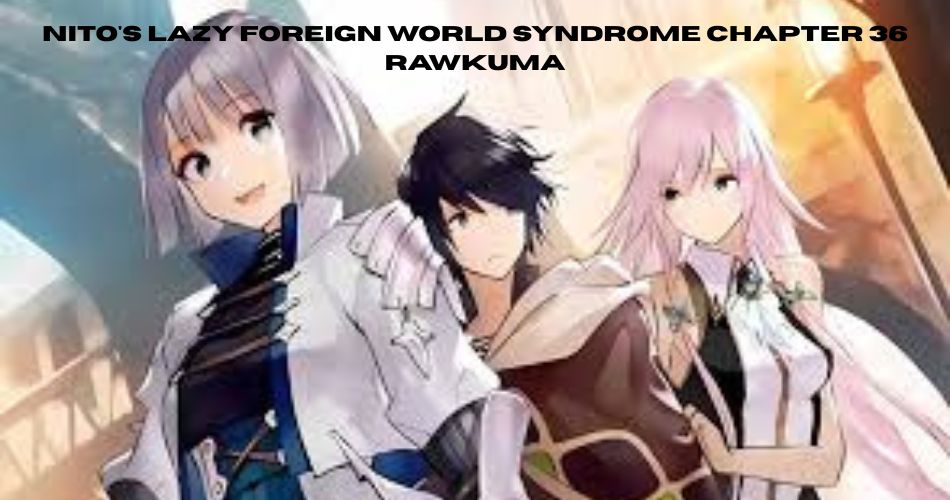Nito’s Lazy Foreign World Syndrome Chapter 36 Rawkuma continues the intriguing saga of a protagonist who refuses to be the hero this fantasy world demands. Unlike the typical upbeat and adventurous characters in most isekai stories, Nito is a brooding figure. His reluctance to engage with the world that summoned him is what makes him stand out. In Chapter 36, now available in raw form on Rawkuma, the narrative leans further into psychological tension, moral dilemmas, and subtle plot turns that signal deeper meanings ahead. As fans dive into the raw scans, even without translation, the emotions painted across each panel and the ominous pacing of the storytelling speak volumes. This chapter is a turning point, not just in action but in tone and thematic intensity, offering a reflective pause in the otherwise chaotic journey.
Recap and Setting the Stage for Chapter 36
Before immersing into the developments of Nito’s Lazy Foreign World Syndrome Chapter 36 Rawkuma, it helps to understand where the story left off. Chapters 34 and 35 presented internal and external battles, as Nito faced confrontations both from enemies and from within himself. The narrative led him to a forsaken village that is now central in Chapter 36. This village, ravaged by magical conflict, stands not just as a physical location but as a symbol of Nito’s fragmented state of mind. What sets the tone for Chapter 36 is not flashy battles, but rather the quiet desperation and eerie calm that hangs in the air before something tragic or momentous occurs. The visuals showcase scorched landscapes, silent townsfolk, and a protagonist who walks alone, both physically and emotionally. It’s a beautiful yet melancholic portrayal of someone losing connection with their surroundings while being dragged into fate.
Unfolding of Emotions and Symbolism Through Nito’s Eyes
Nito’s Lazy Foreign World Syndrome Chapter 36 Rawkuma is layered with metaphor. Nito walks through the destroyed village like a ghost of his former self, his cape torn, his eyes distant, and his body language tired. The way the artist frames Nito in the middle of ruined homes and burned paths screams isolation. Symbolism dominates this chapter. Fire is present in many scenes—not as a source of power, but as a reminder of destruction and choices that can’t be undone. Mirrors appear too, both literal and metaphorical, showing Nito glimpses of who he might have been had he embraced heroism earlier. The quietness of the chapter almost feels louder than any dialogue could be, showing a masterclass in emotional storytelling through raw imagery.
Character Development and the Question of Purpose
Throughout Nito’s Lazy Foreign World Syndrome Chapter 36 Rawkuma, the protagonist undergoes subtle but powerful character development. Readers witness the erosion of his apathy. A once disinterested man who avoided conflict now finds himself compelled to act—not because he’s a savior, but because the world refuses to let him stay uninvolved. The internal dialogue hinted through facial expressions and flashbacks shows a character beginning to question if his avoidance is cowardice or wisdom. He is faced with an injured child during the chapter’s midpoint—a child who does not speak but stares at him with unblinking hope. This interaction is brief, but it encapsulates the larger theme of reluctant responsibility. Nito doesn’t pick up a sword or cast a spell, but he offers the child food and shelter, an act that might seem small but speaks volumes in a world where strength is often measured in violence.
Rawkuma’s Impact and the Role of Raw Chapters
One cannot discuss Nito’s Lazy Foreign World Syndrome Chapter 36 Rawkuma without acknowledging Rawkuma’s role in the manga community. Rawkuma provides access to untranslated manga, allowing fans across the globe to stay in sync with the story’s latest developments. Chapter 36, though still in its raw Japanese form, has already stirred massive discussions online. Forums and subreddits are filled with panel breakdowns, fan theories, and speculations about what’s next. For many, the raw chapters serve not only as a sneak peek but as a genuine emotional experience—especially when artwork conveys more than dialogue ever could. Rawkuma ensures that passion for series like Nito’s continues thriving, regardless of language barriers. The chapter’s pacing, visual language, and emotional undertones are so effective that many fans argue no translation is even needed to feel its impact.
Themes of Escape, Isolation, and Redemption
Nito’s Lazy Foreign World Syndrome Chapter 36 Rawkuma builds upon the recurring themes of escape and isolation. Nito’s journey is not that of a man trying to conquer the world but of someone trying to run from it. However, as the story progresses, it becomes clear that isolation is not freedom—it is its own kind of prison. In Chapter 36, this message becomes especially poignant. The quiet scenes of Nito sitting alone, haunted by echoes of screams and laughter that no longer exist, evoke a sense of crushing loneliness. Redemption becomes a thematic counterbalance. The world might not deserve saving, but Nito slowly begins to believe that perhaps he can still salvage some part of himself through small acts of kindness, responsibility, or resistance. That moral ambiguity—should he save others or focus on his own peace?—drives much of the narrative forward.
Visual Storytelling and Artistic Brilliance in Chapter 36
The art style in Nito’s Lazy Foreign World Syndrome Chapter 36 Rawkuma continues to be one of its strongest points. The chapter is a visual masterpiece, using minimal color contrast and shading to convey mood shifts. Dark clouds roll over the village as Nito arrives, only to part briefly when he interacts with the child—a subtle touch suggesting a momentary light in a dark path. The use of close-ups is especially effective, particularly when focusing on Nito’s eyes or clenched fists. These micro-expressions serve as emotional anchors, giving readers a window into his conflicted soul. The artist also uses wide, empty spaces—panels with little action—to slow down the pace intentionally, mirroring Nito’s internal hesitation. It’s a bold move that pays off, making the reader stop, breathe, and absorb the weight of silence.
A Glimpse into Fan Theories and Chapter 37 Predictions
With Nito’s Lazy Foreign World Syndrome Chapter 36 Rawkuma now in circulation, fans are already throwing around predictions for Chapter 37. One prevailing theory is that Nito will finally confront the summoners who brought him into this world, either by choice or coercion. Others speculate that the cloaked figure watching him from the distance—a new character introduced in the final panel—might be someone from his original world. Reddit threads are buzzing with ideas: will Nito become the very monster he fears? Or will he embrace a new purpose? The ambiguity of Chapter 36 leaves room for all these possibilities, making it one of the most theorized chapters to date. Its slow pace, emotional beats, and cliffhanger ending ensure that anticipation for the next chapter is at an all-time high.
Why Chapter 36 Is a Defining Moment for the Series
Many fans are calling Nito’s Lazy Foreign World Syndrome Chapter 36 Rawkuma the emotional cornerstone of the series. Unlike earlier chapters driven by external conflict, this one is rooted deeply in introspection. It challenges not only Nito but the reader to think about what it means to live, to run, and to take responsibility. It strips away the glamour of the fantasy setting and replaces it with raw, real emotions that many can relate to—feelings of being overwhelmed, disconnected, or trapped by expectations. For a series often categorized under the isekai fantasy label, Chapter 36 dares to be something more. It’s not just another chapter—it’s a mirror held up to the soul of its character and its audience.
Conclusion
Nito’s Lazy Foreign World Syndrome Chapter 36 Rawkuma is not your typical manga chapter filled with sword fights and magic spells. Instead, it is a deeply emotional exploration of a protagonist wrestling with purpose, guilt, and identity. Through masterful artwork, symbolic scenes, and the ever-present silence that fills the panels, Chapter 36 tells a story of internal conflict that hits harder than any battle ever could. For fans of the series, this chapter is a treasure trove of meaning and momentum, signaling that the story is evolving into something even more profound. As we await Chapter 37, one thing is clear—Nito’s journey is far from over, and his story continues to resonate on a deeply human level.
More Topics Worth Exploring:
- Gimkit: A Fun and Interactive Learning Tool for Students
- Gimkit Join: Revolutionizing Classroom Engagement with Game-Based Learning
- Gimkit Home: Transforming Education with Gamified Learning
- Gimkit Code: A Complete Guide to Enhancing Student Engagement
- SERPclix vs SERPSEO: The Ultimate CTR SEO Tool Showdown in 2025



